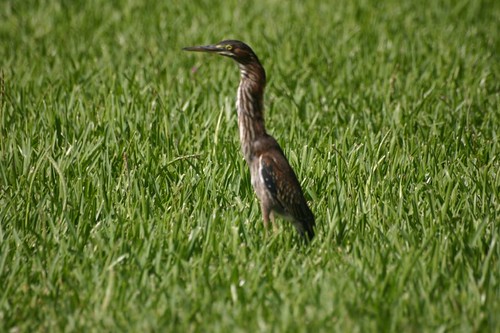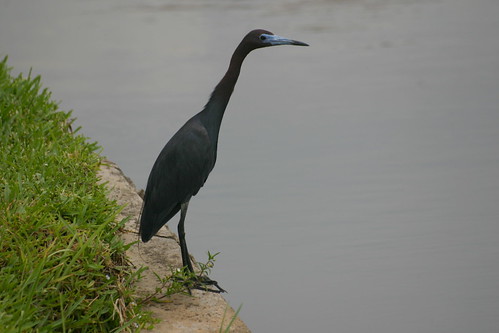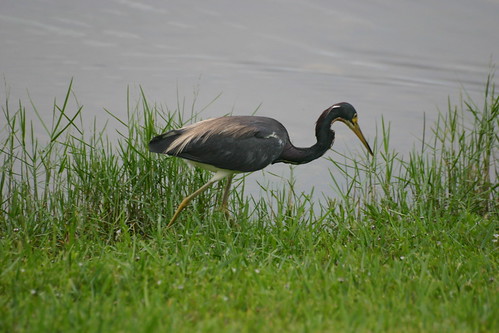Maybe we become just too familiar with yard birds to appreciate some of their interesting and unique characteristics.
The long-legged waders that are so common on our Florida lake are a case in point. At first glance they all seem alike, except for size, shape and color, as they appear along the lake shore and go about the business of finding their meals. I’m noticing two right now, at both size extremes of the heron clan, the Green and the Great Blue Herons. Both are standing there, motionless, staring at the water, ready to strike at the first fish that crosses their paths. Both seem to have favorite “fishing holes.”

Most mornings during the winter, at least when kids are not playing around the lake, I can find a Green Heron crouching inconspicuously near the outlet of the storm culvert on our property line. Likewise, the Great Blue has a spot near a waterside bush a few doors away. Both can be as still as statues for many minutes at a time. However, the Great Blue usually stands in several inches of water, while the Green Heron seems not to like getting its feet wet.

In contrast, the superficially similar Little Blue and Tricolored Herons
are often seen walking along the lake margin. Yet, if our lake were a
racetrack, the Tricolored would probably have lapped the Little Blue several
dozen times before the latter crossed the finish line. Their foraging tactics
differ greatly. The Little Blue seems to spend much of its time enjoying its
reflection, often sitting motionless or stalking furtively with the tip of its
bill in the water, contorting its neck as it moves along. The Tricolored, in its restless fashion, walks back and forth, here and there, striking, probing, wading deeply and then returning to the shoreline, taking short flights, ever changing its mind about where to find the next fish.

Tricolored Heron:

Great Blues and Great Egrets often stalk for reptiles and maybe small birds and mammals in between homes and among lakeside plantings. Though I have never caught one in the act, I suspect they may be the cause of the disappearance of some of our Muscovy ducklings. The hen ducks certainly shepherd their young away from them.
As evidenced by the forward placement of their eyes that permits binocular vision, all of the previously mentioned waders hunt by sight. The White Ibis commonly probes blindly by sweeping its partially open bill from side to side, but also actively grasps prey such as fish, insects, snakes and amphibians. As I have noted [see Trash Birds], this species is very opportunistic, searching our lawn and garbage cans for anything edible. The Wood Stork appears to more consistently catch prey by touch. Its partially open bill clamps down on anything that bumps against it.

I have seen both Wood Storks and herons engage in interesting habits that increase their chances of finding prey. Wood Storks will open and “cup” their wings into an umbrella shape, to shade the water while they probe, presumably to attract small fish into the shadow. They will also stir up the water with their bubble gum-pink feet, to startle the fish and make them blunder into their tactile bills. Tricolored Herons often open their wings briefly and either shade the water to cut down on the glare, or perhaps (as mockingbirds seem to do) to frighten the fish into moving. Snowy Egrets also stir the water with their bright yellow feet, and I have seen Little Blue Herons do the same with their dark feet, though more slowly. Green Herons share this habit, which increases their chances of finding prey.
Herons are usually solitary feeders, though sometimes, around Thanksgiving time (when there seems to be an abundance of smaller fish), we have quite large congregations of Great and Snowy Egrets, [see: Watching the Lake] and have even had ten Great Blues on our small lake. White Ibis (and Glossy Ibis, which sometimes visit) commonly forage in small flocks. Little Blue Herons often join them, possibly attracted by the fish that the ibises find and/or stir up. Presumably for the same reason, Little Blues, Tricolored Herons and both Egret species often follow the Double-crested Cormorants and Anhingas as they dive around the edges of the lake.
The most unusual behaviors I witnessed during the Thanksgiving fish-fest were the Great Blue Heron that swim like a swan in deep water and egrets skimming up fish on the wing, gull-like.
I photographed all of these birds from our back patio.












